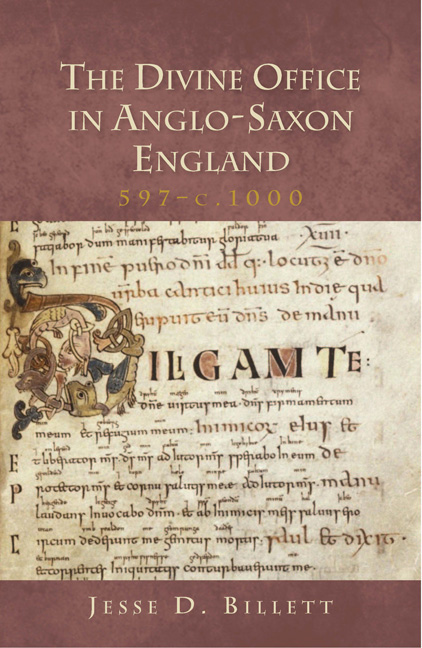Book contents
- Frontmatter
- Dedication
- Contents
- TABLES
- ILLUSTRATIONS
- PREFACE
- NOTE ON USAGE
- ABBREVIATIONS
- MANUSCRIPT SIGLA
- Part I The Historical Development of the Divine Office in England to c.1000
- Part II Manuscript Evidence for English Office Chant in the Tenth Century
- 6 A METHODOLOGY FOR THE STUDY OF ANGLO-SAXON CHANT BOOKS FOR THE OFFICE
- 7 TWO WITNESSES TO THE CHANT OF THE SECULAR OFFICE IN ENGLAND IN THE TENTH CENTURY
- 8 A FRAGMENT OF A TENTH-CENTURY ENGLISH BENEDICTINE ‘BREVIARY’
- 9 A FRAGMENT OF A TENTH-CENTURY ENGLISH BENEDICTINE CHANT BOOK
- 10 CONCLUSION: WAYS OF MAKING A BENEDICTINE OFFICE
- Appendices
- BIBLIOGRAPHY
- INDEX OF MANUSCRIPTS
- INDEX OF LITURGICAL FORMS
- INDEX OF BIBLICAL REFERENCES AND LITURGICAL READINGS
- GENERAL INDEX
6 - A METHODOLOGY FOR THE STUDY OF ANGLO-SAXON CHANT BOOKS FOR THE OFFICE
from Part II - Manuscript Evidence for English Office Chant in the Tenth Century
Published online by Cambridge University Press: 05 November 2014
- Frontmatter
- Dedication
- Contents
- TABLES
- ILLUSTRATIONS
- PREFACE
- NOTE ON USAGE
- ABBREVIATIONS
- MANUSCRIPT SIGLA
- Part I The Historical Development of the Divine Office in England to c.1000
- Part II Manuscript Evidence for English Office Chant in the Tenth Century
- 6 A METHODOLOGY FOR THE STUDY OF ANGLO-SAXON CHANT BOOKS FOR THE OFFICE
- 7 TWO WITNESSES TO THE CHANT OF THE SECULAR OFFICE IN ENGLAND IN THE TENTH CENTURY
- 8 A FRAGMENT OF A TENTH-CENTURY ENGLISH BENEDICTINE ‘BREVIARY’
- 9 A FRAGMENT OF A TENTH-CENTURY ENGLISH BENEDICTINE CHANT BOOK
- 10 CONCLUSION: WAYS OF MAKING A BENEDICTINE OFFICE
- Appendices
- BIBLIOGRAPHY
- INDEX OF MANUSCRIPTS
- INDEX OF LITURGICAL FORMS
- INDEX OF BIBLICAL REFERENCES AND LITURGICAL READINGS
- GENERAL INDEX
Summary
Despite its place at the centre of the Divine Office, the particular arrangement of the cursus of psalmody and readings used in a given church or monastery, once identified, is of limited use and interest. It will be either ‘secular’ or ‘monastic’, except in those rare sources that witness the more fluid situation that prevailed before the spread of the Carolingian two-Office ideal. It is very surprising ever to find an Office book whose disposition of psalms does not correspond to one of the two expected patterns. More often than not, the psalms to be sung at each hour are not even recorded, being too familiar to need explanation. Great variation between different Office manuscripts is found, however, in the chants that accompany the psalms and readings: the antiphons and responsories. Manuscripts of chants for the Mass can display a relatively high degree of uniformity in selection of chant texts without necessarily being closely related. But it is rare to find two Office books in close agreement with each other unless they are from the same locality or they are derived from exemplars circulating in a ‘reform’ movement. This comparable variety makes it possible to compare Office books based on the repertory of chants that they contain and to draw certain conclusions about their relatedness to each other and about the historical circumstances that brought them to their surviving forms.
- Type
- Chapter
- Information
- The Divine Office in Anglo-Saxon England, 597-c.1000 , pp. 199 - 219Publisher: Boydell & BrewerPrint publication year: 2014

